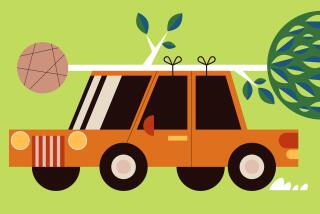Source of New Citrus Trees in State Damaged : Agriculture: A ‘foundation block’ of disease-free trees was devastated by the freeze, dealing a setback to growers seeking to replace frost-damaged stock.
- Share via
EXETER, Calif. — The California citrus industry’s recovery from the Christmas freeze has been set back more than a year because plummeting temperatures have devastated the main source for new trees statewide.
Without the disease-free cuttings that are used to breed at least two-thirds of the state’s new citrus trees, growers will be hard-pressed to replant their groves, which were damaged by nearly two weeks of temperatures that plunged into the teens.
“That’s bad,” said Joel Nelsen, president of California Citrus Mutual, an industry trade group. “A lot of your growers will want to replant because of the devastation. This sets back the recovery process a year.”
This primary source of new citrus trees is a six-acre grove called the “foundation block,” a stand of lemon, lime, grapefruit, orange and citron trees surrounded by chain-link fence and barbed wire at the University of California Lindcove Field Station here in the Tulare County foothills.
When the Arctic Express swooped into California three weeks ago, wreaking an estimated $700 million in damage to fruit, vegetables and trees and knocking 15,000 workers out of their jobs, Tulare County bore the brunt of the disaster. The price tag: $286 million and still counting.
The cold damaged budwood on most of the orchard’s 400 trees.
Under normal circumstances, budwood is sliced from these parent trees and sold to nurseries throughout the state for 75 cents a bud.
Nursery owners then graft the buds on to seedlings. The buds sprout into young trees, which provide more buds and eventually are used to replant orchards. The Lindcove station sells between 50,000 and 70,000 buds each year.
The buds’ value lies in the fact that they contain no orchard-killing viruses, said John Pehrson, a subtropical horticulturist at the station. To protect the $1-billion citrus industry, all California orchards must be planted with trees grown from registered stock. Lindcove is the primary source.
The freeze damaged the budwood at the foundation block so seriously that the field station, a University of California citrus research laboratory, has stopped citrus bud sales for six to 18 months.
“I don’t think we’ve lost any trees, but we’ve damaged a lot of wood,” Pehrson said as he strolled through the station’s groves checking the trees. “That’s why we’re out of the budwood business. . . .We don’t think any nurserymen would want budwood off that tree.”
The field station usually sells buds three times each year, in fall, spring and winter. The winter sale, which happens in January, is the most important and is the first affected. Pehrson said the first time buds could be sold again is in the fall, but even that is not certain.
Last fall’s sale was also postponed because researchers found two trees infected with the virus tristeza and briefly quarantined the grove. So growers will be at least a full year without new cuttings.
“It’s a severe problem,” said Roger Smith, who manages sales and grower relations at Michaelis Nursery in Porterville. “Foundation block is the main place we go. It’s very well-maintained.”
Nurseries are busy scouring the state for registered and tested trees, Smith said, and “not every variety we want will be available.”
The burned leaves, split bark and rotting fruit that plague Tulare County’s growers are in evidence throughout the 175-acre research station, where citrus research on topics from pest control to irrigation also is conducted.
Among the most crucial are the University of California’s efforts to find non-chemical pest control methods to replace agricultural pesticides. The freeze has delayed that research also, said Louis Whitendale, Lindcove station superintendent.
The freeze killed beneficial insects “involved in projects attempting to develop pest control strategies to use less pesticides,” Whitendale said. “It set us back a year in showing how we can use those.”
But the loss of disease-free buds to propagate new trees was the greatest freeze loss at Lindcove, industry experts said.
Lindcove “is the source of all new varieties as well as established ones,” said Bob Zuckerman, owner and manager of B&Z; Nursery in Porterville.
“It’s the only source tested and cleared of viruses,” he said. “That’s why it’s so important to the industry.”
* BONANZA IN FLORIDA: Florida is harvesting its largest orange crop in a decade. D2
More to Read
Inside the business of entertainment
The Wide Shot brings you news, analysis and insights on everything from streaming wars to production — and what it all means for the future.
You may occasionally receive promotional content from the Los Angeles Times.











